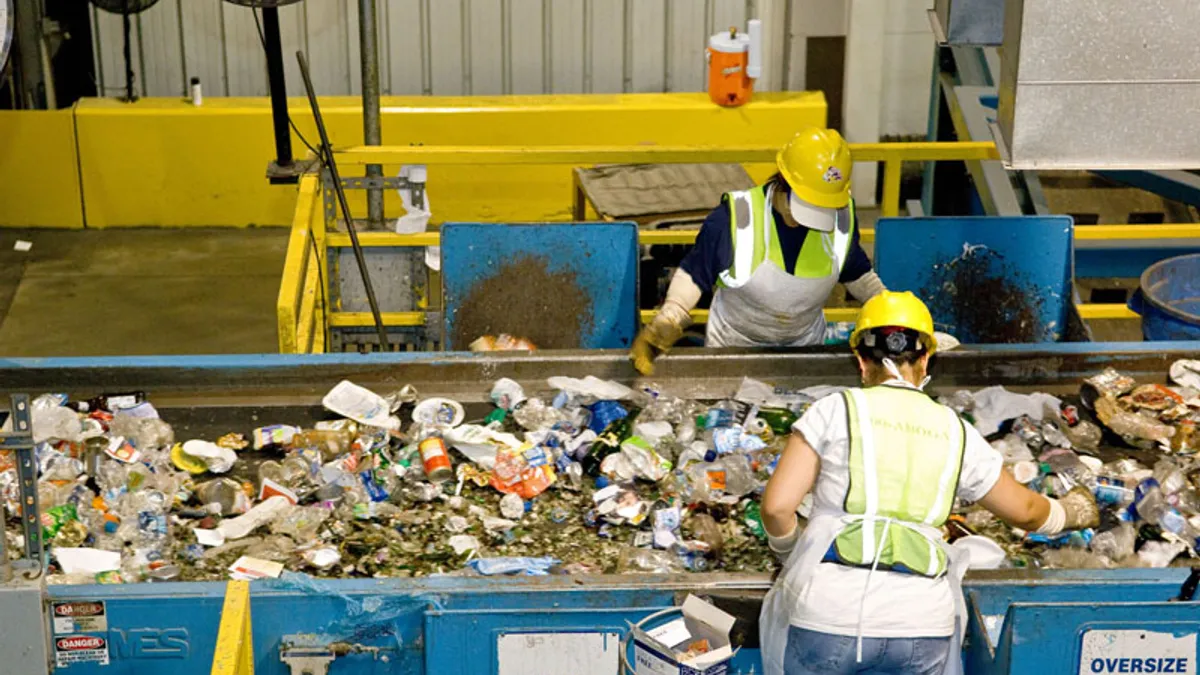Dive Brief:
- The injury and illness rate for MRF workers shot up from a rate of 6.0 incidents per 100 full-time employees in 2016 to 9.8 in 2017, according to new Bureau of Labor Statistics data. The rate for cases that involved days away from work was 5.8.
- The overall injury and illness rate for the "waste management and remediation services" category, which also includes hazardous waste and other sectors, increased from 4.0 to 4.2. The rate for solid waste collection workers decreased slightly from 5.2 to 5.1, while the rate at landfills increased from 4.9 to 5.3. Injuries and illnesses also ticked up slightly at waste-to-energy (WTE) facilities from 1.0 to 1.3.
- “Today’s BLS release of industry injury and illness data illuminates the progress being made to improve safety performance nationwide, but shows we still have work to do,” said NWRA President and CEO Darrell Smith in a statement. SWANA CEO David Biderman called the increase for MRF and landfill workers "concerning" in his own statement. He added, "Coupled with the uptick in fatal incidents that have occurred this year, it is clear that a lot more needs to be done to improve the industry’s safety record."
Dive Insight:
All of these rates, aside from WTE facilities, are higher than the improved 2017 national average of 2.7 for all occupations. BLS estimates that 2.8 million nonfatal injuries and illnesses were reported by private industry employers in 2017, which was approximately 45,800 fewer than in 2016.
The ongoing focus on collection work, which regularly sees more fatalities than any other industry occupation, has yielded positive results that appear to continue with this new BLS data. In its statement, NWRA touted the passage of Slow Down to Get Around laws in 22 states as a way to help protect workers on their routes, saying that collaboration is ongoing with technology companies in multiple sectors to "understand opportunities to further safeguard employees." The NWRA Board of Trustees has also made safety a "strategic initiative."
SWANA highlighted communication with its own network of "safety ambassadors" in 45 chapters about the new data and released a "Hauler Safety Tookit" over the summer. However, Biderman noted in his own statement, "Passing more Slow Down to Get Around laws is nice, but won’t be sufficient."
Given that many MRF operators have increased their staffing over the past year to meet tighter quality standards, and the fact that stockpiled bales may create tighter operating conditions at some facilities, a certain level of change between the 2017 and 2018 injury rates is to be expected. NWRA's press release said that "improving the MRF rate will be challenging," and it would seem that prioritizing solutions will be difficult without better data on what drove this uptick.
An initial review of the BLS data for 2017 appears to show the majority of MRF injuries were vehicle-related, though potential accounting inconsistencies and missing data points raise the question of whether year-to-year comparisons are accurate. For example, the only injuries reported at MRFs in 2017 occurred on Wednesdays, whereas in prior years they were reported on multiple days at facilities that often operate six days a week.
Waste Dive will be following up on these questions, but in the meantime, this new BLS data further illustrates that working in MRFs can be similarly hazardous to other higher-profile industry occupations under even the best circumstances. As pressure increases on MRF standards and operating capabilities, labor conditions for the workers involved deserve equally urgent attention.














